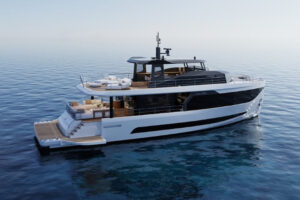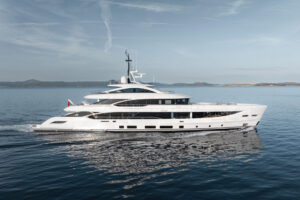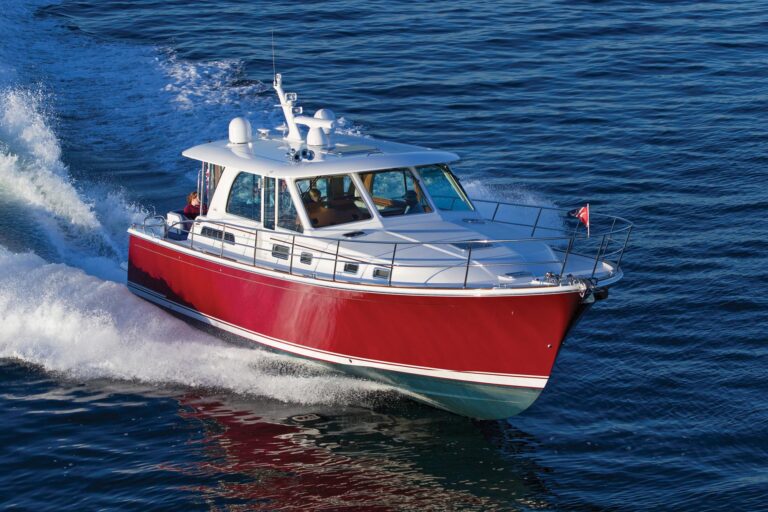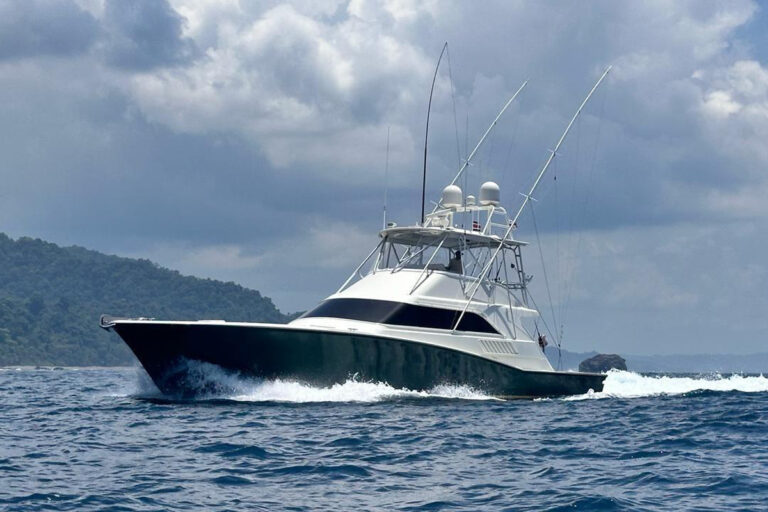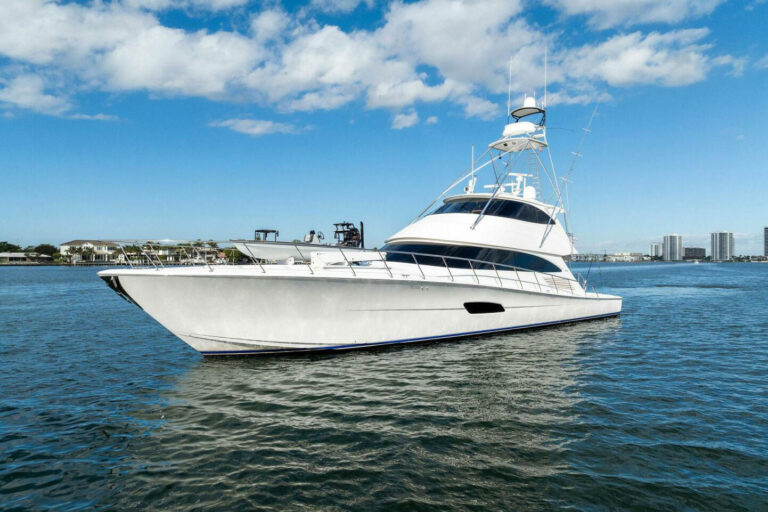Autumn along the coast of New England awakens nature’s charm like no other time of year. This past November, brisk northwesterly breezes scoured away the yellow-gray mist of summer’s inversions, leaving the sky a sharp blue and the air as crisp as a freshly laundered shirt. From time to time, a dense cloud the color of tarnished pewter cast a giant shadow over the foreground, while the background basked in platinum brightness. This was a perfect day on Rhode Island’s Narragansett Bay to begin a short sail aboard a perfectly rendered cruising yacht.
When I say perfect, I mean “complete and lacking nothing essential; excellent or ideal in every way; having all the necessary or typical characteristics required for a given situation (Merriam-Webster)”. Perfection is what a yachtsman gets when he selects a designer and builder who know how to interpret his visions-in this case, Visions of Johanna, Morris 62, hull number one.
Designer Chuck Paine derived this Morris 62 from his Bermuda series of fast offshore-cruising yachts, in which he combines the comfort and security of a pilothouse with practical accommodations. Placing all the machinery abaft the accommodations gives the arrangement plan a spacious guest stateroom aft, a galley opposite, an impressively large saloon amidships, a small upper/lower double guest stateroom forward of the saloon and a luxurious owner’s cabin in the bow.
Providing this much interior volume in a 62-foot yacht requires careful design. The compromises begin with the fast passages, which demand a relatively shallow hull of moderate prismatic coefficient-meaning Paine has drawn out the volume below the waterline. The entry is fine, but not overly so, and forms a narrow U-shape in the first few stations. This U-shape gradually broadens to a semi-ellipsis, growing flatter in the run than it is amidships. Paine carried a large percentage of the maximum beam (at the waterline) into the after sections to provide enough buoyancy to support the machinery under the cockpit. He also kept the hull fairly deep for a short distance abaft the keel to add still more buoyancy. The good news for comfort at sea-you won’t find a flat spot anywhere on the bottom, and the distribution of volume below the waterline prevents excessive pitching in a seaway.
In exchange for the speed, achieved via the shallow hull and light displacement, combined with a spacious arrangement plan, the owner has to live with the appearance of bulk in the topsides. I’m happy to report that Paine is a master at disguising bulk. He has hidden it behind a subtle sweep in the sheerline and a line of six portlights on each side immediately below the rub rail. The bulwarks help, too, by masking the height of the trunk cabin. On the other side of this compromise lays the exceptional amount of reserve stability the Morris 62 gains as she heels onto her tall topsides. She’ll quickly recover from any knockdown.
The 62 promises comfort aboard at sea or in harbor. Natural light from what seems like an acre of glass in the house washes the saloon and forwardmost section of the galley. On a sunny day, such as the one that graced my test sail, the saloon doesn’t need electric lighting, except perhaps for reading in the crotch of the L-shape settee or in the forward lounge chair on the saloon’s starboard side. Additional light enters from two hatches in the overhead and from the portlights in the topsides.
You’ll find plenty of natural light in the galley, too. Though it’s tucked into a narrow area on the starboard side of the companionway, it receives light from three overhead hatches and two portlights. Here, the cabinetry wears a soft-white Awlgrip finish, trimmed with bright-finish cherry. The area positively glows.
I’m not crazy about in-line galleys, but this one is narrow enough to let the chef brace himself against the boat’s motion. Tending pots at the stove, the chef need only turn 180 degrees to access the deep stainless-steel sink. Shuffling a couple of steps to his left places him in front of the two-level refrigerator. The freezer is below the counter and a side step forward of the stove. We could measure the counters in square feet, the area seems so large, and 2-inch fiddles keep everything from escaping to the sole. Owners should find all the dry stowage and refrigeration they need for long-range cruising.
At the after end of the galley is the engineroom, closed off from the accommodations by a watertight door. A workbench and toolbox occupy the starboard side of the space beneath the cockpit seat, permitting a reasonable amount of headroom-at least for anyone short of average. The engineer will thank the designer and builder for providing so much space around the engine and such easy access to the items that require routine maintenance. As is typical of Morris Yachts, everything is labeled and neatly installed.
The true joy of owning a yacht of this pedigree comes from sailing her. Narragansett Bay is no substitute for the high seas, but my imagination transcended our limits. We got under way in about 15 knots of true wind and sailed toward the open ocean on a broad reach. We were a crew of six, Chuck Paine and Tom Morris among us. Clustered near the twin wheels, the group realized the propeller was turning. We could hear the gears spinning, and we had no other explanation for our lack of speed-barely 7 knots under the light air-reaching sail and full main. A peek into the engineroom confirmed that the prop-shaft brake for the Autoprop wasn’t working. The turning prop lopped a couple of knots off our projected top speed. This was unrelated to the installation; the brake was simply defective.
Nonetheless, Visions of Johanna was a delight to sail. Her exceptional stability will inspire confidence in any helmsman, but it’s especially endearing to guests, who can move around without lessons in mountain climbing. The twin wheels let the helmsman see around the pilothouse without straining and view the telltales on the headsails. She balances well on all points of sail, steers accurately and promises to reach double-digit speeds.
When the weather turns ugly, the helmsman and standby watch mate can take shelter in the pilothouse and let the autopilot do the driving. The pilot berth makes a most comfortable perch for anyone who wants to escape the sun, wind, rain or cold. A full array of electronics handles navigation and communication.
Boston Boatworks built the epoxy composite hull and deck, and Morris Yachts completed it. Among its high-tech features are a carbon-fiber rudder and composite chain plates. Though Visions of Johanna wears a lot of shiny jewelry on her deck, you won’t find any wood. Her owner was smart to avoid such decoration, since he prefers sailing to varnishing.
At 62 feet LOA and 56,500 pounds, Visions of Johanna is small enough for a couple to handle alone. On the other hand, her spacious interior gives the owners the option to carry a professional captain or a handful of friends. Let us award her the seal of perfection for meeting the owner’s criteria.
Contact: Morris Yachts, (207) 244-5509; sales@morrisyachts.com; www.morrisyachts.com. For more information, contact: (866) 922-4877; www.yachtingnet.com/yachting/productinfo.


